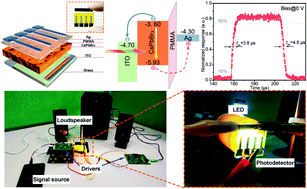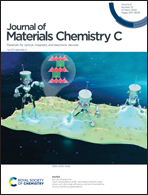Ultrafast, self-powered and charge-transport-layer-free photodetectors based on high-quality evaporated CsPbBr3 perovskites for applications in optical communication†
Abstract
Perovskite photodetectors, with the merits of excellent light absorption, high carrier mobility and fast light response, are attracting tremendous interest for their promising application in optical communication, sensing and imaging. However, the requirement of a power supply for photoconductive detectors or the usage of expensive charge transport layers for photovoltaic detectors will pronouncedly increase the whole costs and process complexity. Herein, we demonstrate a self-powered inorganic perovskite photodetector with a novel and simplified configuration of ITO/CsPbBr3/Ag. Since no electron and hole transport layers are employed, it is highly necessary for the CsPbBr3 layer to prevent direct contact between the anode and cathode. Hence, we develop a sequential evaporation technique to fabricate a high-quality CsPbBr3 photosensitive film, which is more controllable than the traditional solution-processing route. The evaporated CsPbBr3 film obtains a much higher crystallinity, phase-purity, coverage and light harvesting capability than the conventionally solution-processed counterparts. The evaporated CsPbBr3 also exhibits larger grain sizes with fewer grain boundaries, enabling a faster charge transport and shorter photoresponse time of 54 ms for the photodetectors. After modification by a thin polymethyl methacrylate (PMMA) layer, the trap states and leakage current pathways in the CsPbBr3 film are substantially decreased, yielding an improved carrier lifetime and suppressed recombination loss. The PMMA-modified photodetectors achieve an ultrafast response time of 3.8 μs and an ultrahigh on/off ratio of 3.5 × 104, which are the best performance among all the reported charge-transport-layer-free perovskite photodetectors and surpass most of the perovskite photodetectors even with charge transport layers. The as-fabricated CsPbBr3 detectors also present superior stability after being stored in ambient air for over 1000 h. Moreover, our devices are successfully applied in a home-made visible light communication system as light receivers to transmit audio signals. Our work solves the contradiction between high detection performance and structure simplification, promoting practical applications of cost-effective, ultrafast and stable inorganic perovskite photodetectors in the optoelectronic field.



 Please wait while we load your content...
Please wait while we load your content...